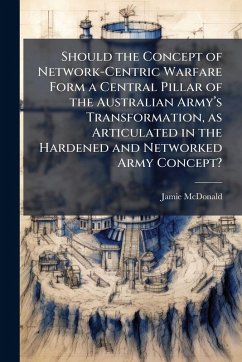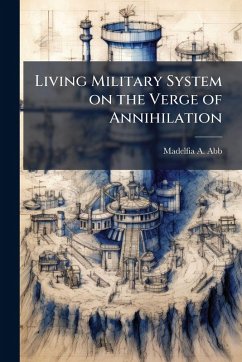
Network Centric Warfare, Command, and the Nature of War
Versandkostenfrei!
Versandfertig in über 4 Wochen
15,99 €
inkl. MwSt.
Weitere Ausgaben:

PAYBACK Punkte
8 °P sammeln!
Military theorists such as David Alberts contend that information technologies will allow for wider and more rapid sharing of information. In order to take advantage of the emerging possibilities presented by information technologies the theorists recommend changes to the structure of information age military organizations and changes to the methods for command and control of military forces. Some of their ideas have implications for the traditional function of command. This monograph asks how contemporary military theorists account for the essence of command in information age theories of war...
Military theorists such as David Alberts contend that information technologies will allow for wider and more rapid sharing of information. In order to take advantage of the emerging possibilities presented by information technologies the theorists recommend changes to the structure of information age military organizations and changes to the methods for command and control of military forces. Some of their ideas have implications for the traditional function of command. This monograph asks how contemporary military theorists account for the essence of command in information age theories of warfare. Case studies of Frederick the Great, Napoleon Bonaparte, and Dwight D. Eisenhower demonstrate that the essence of command is the dynamic relationship among nine imperatives. These imperatives include context, action, nerve, presentation, design, intellect, expertise, coherence, and the individual. The monograph contends that the emerging information age theories of warfare are flawed because they are based on a definition of command that does not account for these imperatives. The monograph serves as a warning to those who might seek to optimize an army for network centric warfare. This work has been selected by scholars as being culturally important, and is part of the knowledge base of civilization as we know it. This work was reproduced from the original artifact, and remains as true to the original work as possible. Therefore, you will see the original copyright references, library stamps (as most of these works have been housed in our most important libraries around the world), and other notations in the work. This work is in the public domain in the United States of America, and possibly other nations. Within the United States, you may freely copy and distribute this work, as no entity (individual or corporate) has a copyright on the body of the work. As a reproduction of a historical artifact, this work may contain missing or blurred pages, poor pictures, errant marks, etc. Scholars believe, and we concur, that this work is important enough to be preserved, reproduced, and made generally available to the public. We appreciate your support of the preservation process, and thank you for being an important part of keeping this knowledge alive and relevant.












